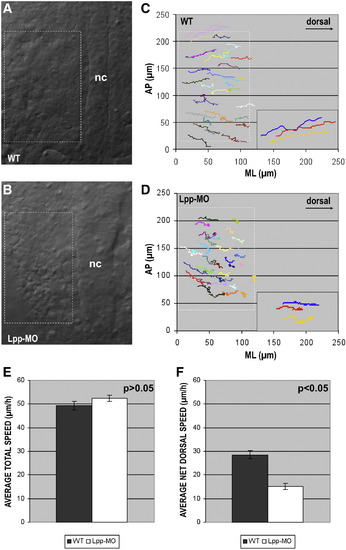Fig. 4
- ID
- ZDB-FIG-080828-4
- Publication
- Vervenne et al., 2008 - Lpp is involved in Wnt/PCP signaling and acts together with Scrib to mediate convergence and extension movements during zebrafish gastrulation
- Other Figures
- All Figure Page
- Back to All Figure Page
|
Lpp function is required for efficient dorsal convergence. Dorsal views of (A) wild-type (WT) and (B) Lpp-MO/ATG (5 ng) injected embryos at tailbud stage (boxes highlight the paraxial region, which was the focus of the migration analysis). (C, D) Cell tracks of paraxial cells from (C) wild-type and (D) Lpp-MO/ATG injected embryos extracted from Normarski time-lapse images. Each graph shows representative data obtained from individual embryos. Insets are enlarged tracks of three representative cells. AP, anterior–posterior axis; ML, mediolateral axis. (E) No significant (p = 0.19) difference in total speed (μm/h) could be detected between wild-type and Lpp-MO/ATG injected embryos, (F) whereas net dorsal speed after Lpp-MO/ATG injection was significantly (p = 1.1 x 10- 8) reduced. (E, F) Graphs represent average data from 60 cells from 2 embryos for each condition; error bars represent standard errors of the mean. |
| Fish: | |
|---|---|
| Knockdown Reagent: | |
| Observed In: | |
| Stage: | Bud |
Reprinted from Developmental Biology, 320(1), Vervenne, H.B., Crombez, K.R., Lambaerts, K., Carvalho, L., Koeppen, M., Heisenberg, C.P., Van de Ven, W.J., and Petit, M.M., Lpp is involved in Wnt/PCP signaling and acts together with Scrib to mediate convergence and extension movements during zebrafish gastrulation, 267-277, Copyright (2008) with permission from Elsevier. Full text @ Dev. Biol.

